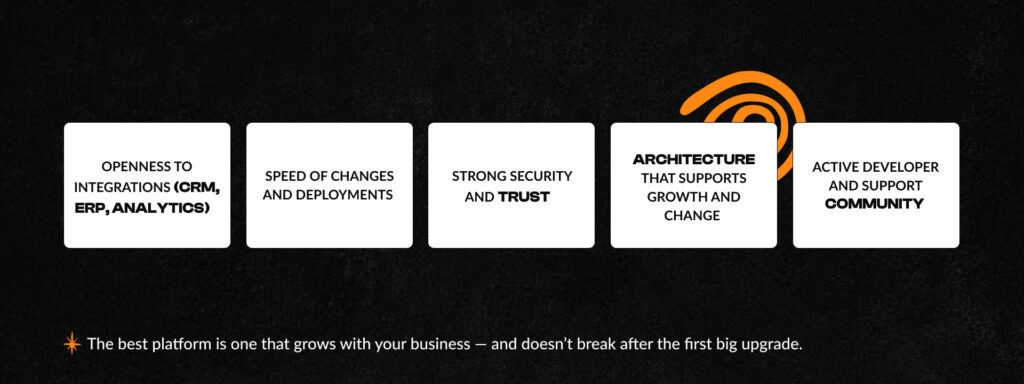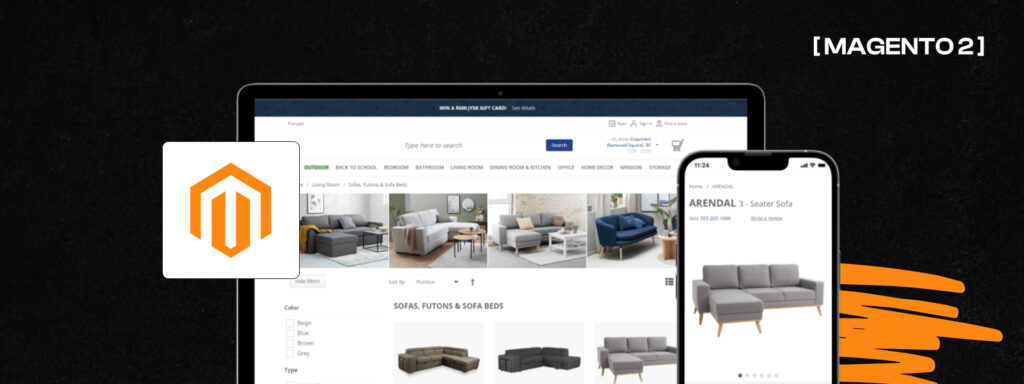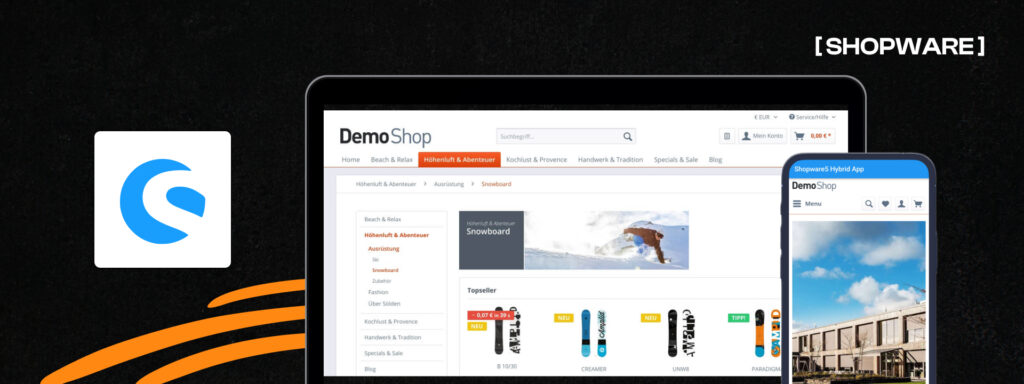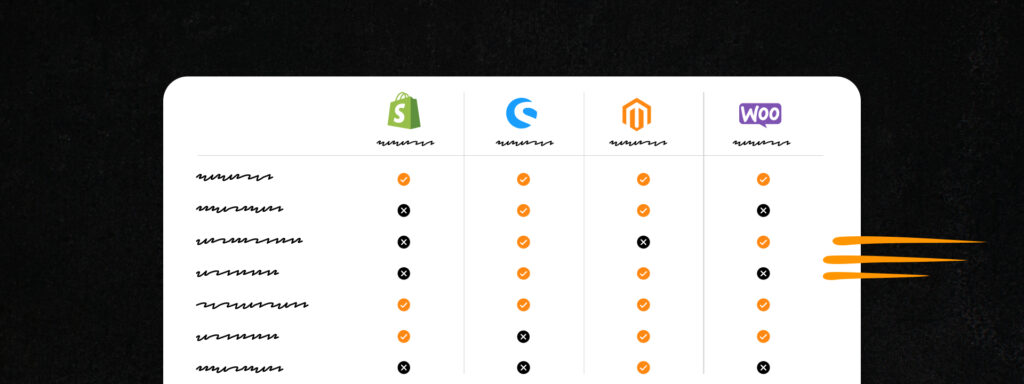An online store is not just a website with a shopping cart and pictures, but a business tool. It can either increase your profits or take away your time and money. Therefore, choosing the platform on which everything works is like selecting a foundation. If you make a mistake at the start, you will have to redo everything from scratch. Today, the market offers dozens of popular e-commerce solutions. Magento, Shopify, Shopware, and WooCommerce are familiar names. Each has its users and success stories. But when it comes to a specific business, the real search for the perfect solution begins. Some recommend Shopify because it’s simple, while others prefer Magento. There are also fans of WordPress + WooCommerce.
And here arises the paradox of choice: there is a lot of information, even more advice, but no universal answer. What is ideal for a drop shipper on Instagram may not be suitable for a B2B company with custom integrations. That is why you need to figure out which platform is best for you. Let’s determine which platform is best for an online store and explore the differences between Shopware, Shopify, WooCommerce, and Magento.
How to Choose the Best eCommerce Platform for Your Business
Choosing an eCommerce platform is not a technical issue, but a strategic one. It is a decision that directly affects business processes, customer experience, operating costs, and scalability. A mistake at this stage costs not only money, but also time, resources, and opportunities.
You can change platforms at any time. But in practice, it is a complex process that requires transferring your product base, users, orders, SEO structure, integrations, and technical settings from scratch. It is expensive, time-consuming, and risky. The platform is the foundation. It either supports business growth or limits its development. If the system does not fit your model or is unable to adapt to new needs, problems arise in daily tasks.
When the platform isn’t the right fit, problems often build up quietly until they can no longer be ignored. The website slows down, frustrating visitors and potentially driving away potential customers. As performance declines, your team might feel overwhelmed with manual tasks such as processing orders, managing data, and updating content. This can leave less time for the growth and exciting opportunities ahead.

Simple improvements, such as adding features or integrations, can become complicated, time-consuming projects full of technical compromises. Meanwhile, support and maintenance costs continue to rise, yet the system remains just as limited. In the end, it’s not that you lack ambition; it’s just that your platform needs to catch up with your big ideas and development plans. Sometimes, things take time to align, but your vision remains inspiring.
As a result, the business loses flexibility, time, and competitiveness. That is why the choice of platform must be carefully considered, taking into account not only today’s tasks but also goals for the next year or two.
Why Choosing the Right Platform Matters?
It’s easy to get confused when it comes to e-commerce. Shopify seems intuitive and easy to use, while Magento is associated with power. WooCommerce is convenient for those who already have experience with WordPress. But popularity alone does not guarantee that a solution will be effective in your particular case.
Often, businesses choose a platform based on the principle that if it works well for someone else, it will also work well for them. But enterprises are rarely identical. Even similar projects can have completely different internal processes, teams, budgets, and development plans. As a result, what works successfully in one case may hinder growth in another.

There are several reasons why a popular eCommerce platform may be ineffective in your particular case.
Reason #1: Each business has its own structure and process logic, which do not always fit within the limitations of a particular platform.
Reason #2: Not all systems allow flexible customization or scaling without significant development costs.
Reason #3: An interface that is convenient for a designer or owner may create difficulties for a marketer, sales manager, or logistician.
Reason #4: The pricing model may seem affordable initially, but at the scaling stage, it can lead to regular overspending.
Before selecting the best eCommerce platform for 2025, it is worth asking a simple question: Will it be the best fit for my business, considering my tasks, team, vision, and customers?
How to Pick an eCommerce Platform That Matches Your Needs
Choosing a platform is not just about functionality. It’s about the business model, the team members, the existing processes, and the ones you plan to scale. Often, mistakes are made not because of technical ignorance, but because of an inability to see the big picture.

To avoid pitfalls, it’s worth relying on proven questions:
- What volume of goods and what growth do you plan in 6, 12, and 24 months?
- Are there team members who will administer the platform? If so, what is their level of technical training?
- How important is the speed of launch? Is this an MVP for 3 months or a long-term flagship?
- Are there any must-have integrations, such as CRM, 1C, third-party warehouses, or marketplaces?
- Are you planning to enter other markets? Select the best platform for international e-commerce that supports multilingualism and multiple currencies.
Your answer will help you choose something that will work with you, not against you.
Budget, Resources, Scale: Things That Are Often Forgotten
Platforms look perfect in presentations. But in real life, it’s not just “what’s possible” that matters, but also “what you can handle.” Companies with small budgets often choose Shopify because it’s easy to launch and doesn’t require significant upfront investments. However, a month later, they may find that the basic functionality is insufficient, and adding particular custom features can become complicated and expensive. Or, conversely, large businesses choose WooCommerce and then discover that the system cannot handle the load or complex logic.
To avoid issues, plan ahead: set your budget for initial development and ongoing monthly support, evaluate the complexity of your product catalog, and identify essential automation processes. Consider how many users will utilize the platform daily and whether flexible, custom features are necessary or ready-made solutions will suffice. Remember, there’s no “cheap and cool;” it’s either affordable or impressive. It’s better to assess resources early than pursue unrealistic features.
Ready to choose an eCommerce platform that fits your unique needs?
Reach out to IT Delight now!
Scalability Starts with the Right Platform
The choice of platform is the foundation that either allows you to scale or makes development look like an obstacle course. Here’s how the platform can affect your growth:
- Openness to integrations determines how easily new systems, such as CRM, ERP, and analytics, can be added.
- The speed of change and deployment affects your response to the market, such as a new promotion, a new segment, or a new shopping cart logic.
- The level of security is directly related to customer trust and income stability.
- The flexibility of the architecture determines whether you can rebuild your business processes without a total redesign.
- The presence of a professional community allows you to find developers, solutions, and support.
The best platform is not the one that has everything. It is the one that grows with your business and doesn’t crash after the first significant upgrade.

Which eCommerce Platform Wins Where?
Each platform has a specific positioning and scenarios where it demonstrates maximum efficiency. All four systems have their strengths and weaknesses. Decisions should be made not based on big names, but taking into account the specific situation, budget, team, and development strategy for the coming years. And most importantly, you need to match your goals with the system’s capabilities correctly.
Magento: Full Control and Customization for Complex Stores
Magento is suitable for large and complex eCommerce projects with high requirements for functionality and customization. It is the choice for companies that require control over all processes, complex catalogs, integration with ERP or CRM, B2B support, and multi-currency capabilities.

Pros:
- Unlimited flexibility in customization and architecture
- Support for multilingualism, multi-currency, and B2B functions
- Ability to deeply integrate with any external systems
- Large and active developer community, so you can always find support, plugins, or ready-made solutions.
Cons:
- High launch and maintenance costs
- Need for an experienced technical team
- Slow launch compared to ready-made solutions
Shopify: Ease of Use and Speed for Quick Launches
Shopify is focused on quick start and ease of management. It is the best eCommerce CMS for a fast start, especially for medium-sized businesses that want to enter the market with minimal technical issues. Everything works “out of the box,” support is on point, and scaling is possible through applications.

Pros:
- Minimal launch time without in-depth technical knowledge
- Access to Shopify Academy for learning eCommerce essentials and platform best practices
- Intuitive interface and a large selection of themes
- Reliable technical support and numerous integrations
Cons:
- Limited customization without paid apps or development
- Regular payments for the platform and apps
- Less flexibility for non-standard business models
Shopware: Flexibility and Innovation for Growing Businesses
Shopware is rapidly gaining popularity outside Europe, particularly among companies that value a modern approach to UX and marketing. The platform is built on the Symfony technology stack, has a convenient backend, and is well-suited for customized solutions.

Pros:
- Modern architecture and logical backend structure
- Balanced ratio between flexibility and simplicity
- Focus on UX, personalization, and visual content
Cons:
- A less developed ecosystem outside German-speaking markets
- Requires technical knowledge for customization
- More challenging to find a team with experience than for Magento or Shopify
WooCommerce: WordPress-Based Freedom with Plugins Galore
WooCommerce will be convenient for those who already work with WordPress or want to have complete control over the site. The solution scales well within small and medium-sized businesses, especially in content-oriented projects.

Pros:
- Full integration with WordPress and an SEO-friendly environment
- Numerous free and paid plugins
- No monthly license fees
Cons:
- Limited performance with a large number of products
- Dependence on hosting and plugin quality
- Not the best solution for rapid scaling
Signs You Need to Switch eCommerce Platforms
Businesses change. And with them, the requirements for technical infrastructure evolve too. Yet many owners delay switching platforms until the last moment, simply because things seem to be working. But if a platform doesn’t let you grow, it holds you back — quietly, but steadily.
Sometimes, signs are subtle at first, like a minor website update feeling monumental with mismatched timelines. Integrating new features becomes tough, workarounds increase, and site performance drops. Support teams are overwhelmed. Maintenance costs rise, overshadowing returns. Global expansion becomes unfeasible due to system limits, indicating you’ve outgrown your foundation.
Understanding this is just the initial step. The next step is to act on it wisely. You can change the platform, but doing it right requires a cool head. Rushing into a new system without understanding the problems of the old one is a significant mistake. Start with a business audit to identify bottlenecks, gaps, and where customers are losing their way.

Then choose a platform that matches your growth plans, not just what your competitors or friends use. Plan the migration carefully. Focus on all essential details, including products, customer data, SEO, and integrations. Each element matters. The budget is not only for development but also for testing, team onboarding, and post-launch support. And unless your team has extensive migration experience, consider bringing in those who do. Otherwise, you may have a system that is technically operational but unusable in practice. Change can be challenging, but remaining stuck incurs much greater costs.
The Right Platform Starts with the Right Questions
Picking an e-commerce platform requires more than comparing features. The decision must be based on how your business operates, scales, and serves customers. At IT Delight, we begin with a thorough analysis. We examine the current challenges, technical constraints, internal workflows, and long-term goals that impact your business. Only after this do we recommend a specific platform, such as Magento, Shopware, Shopify, or WooCommerce, based on business fit, rather than personal preference. Our specialists will manage the whole transition process. Every stage, from architecture and data migration to testing, launch, and support, is carefully planned and executed with precision. A well-chosen platform removes friction, supports growth, and stays aligned with the business as it evolves.
Why We Don’t Push One-Size-Fits-All Solutions
At IT Delight, we understand that every business is different. That’s why we don’t push a particular technology, platform, or trendy solution simply because it’s popular or heavily marketed. Instead, we work as your technology partner — helping you weigh the pros and cons, clarify your growth strategy, and match your business processes to the platform that best serves them.
Our experience with Magento, Shopware, Shopify, WooCommerce, and other technologies allows us to make recommendations based on facts, not opinions. We analyze your business goals, technical requirements, budget, and timeline to propose a solution that meets your needs. Sometimes that means suggesting a powerful, customizable enterprise platform; other times, a fast and flexible SaaS product is the more brilliant move.
Ultimately, platform decisions should be informed by data and expert advice, not sales hype. Our goal is to empower you with knowledge, so you can invest in a solution that is truly aligned with your needs, both today and in the years to come.
Looking for the best eCommerce platform 2025 to scale your business?
Contact IT Delight today for the perfect solution and confident growth.
Conclusion: There Is No Universal Solution, Only Your Scenario
So, now you know how to choose an e-commerce platform for an online store. It’s not about fashion, but about strategic fit. There is no such thing as a perfect CMS that suits everyone. You, your goals, resources, team, market, and vision for the next 1–2 years should dictate your choice.
At IT Delight, we work with the most powerful and flexible eCommerce platforms: Magento, Shopware, Shopify, and WooCommerce. Our team has deep expertise in each and helps businesses choose the one that best suits their specific needs and growth plans.
Magento is suitable for building a complex ecosystem with custom logic, full control, and future scalability. Shopify is ideal for startups that want to enter the market quickly and without technical challenges. Shopware is the perfect choice for those seeking a modern, responsive solution that prioritizes UX and flexibility. And WooCommerce works when you need simplicity, a familiar environment, and control without monthly fees. The key is not in the platform itself but in how you use it. If you’re still unsure which platform is best for you, message us. We’ll be happy to chat and help you figure it out together.
